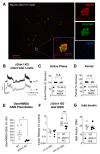Acute D-Serine Co-Agonism of β-Cell NMDA Receptors Potentiates Glucose-Stimulated Insulin Secretion and Excitatory β-Cell Membrane Activity
- PMID: 33430405
- PMCID: PMC7826616
- DOI: 10.3390/cells10010093
Acute D-Serine Co-Agonism of β-Cell NMDA Receptors Potentiates Glucose-Stimulated Insulin Secretion and Excitatory β-Cell Membrane Activity
Abstract
Insulin-secreting pancreatic β-cells express proteins characteristic of D-serine regulated synapses, but the acute effect of D-serine co-agonism on its presumptive β-cell target, N-methyl D-aspartate receptors (NMDARs), is unclear. We used multiple models to evaluate glucose homeostasis and insulin secretion in mice with a systemic increase in D-serine (intraperitoneal injection or DAAO mutants without D-serine catabolism) or tissue-specific loss of Grin1-encoded GluN1, the D-serine binding NMDAR subunit. We also investigated the effects of D-serine ± NMDA on glucose-stimulated insulin secretion (GSIS) and β-cell depolarizing membrane oscillations, using perforated patch electrophysiology, in β-cell-containing primary isolated mouse islets. In vivo models of elevated D-serine correlated to improved blood glucose and insulin levels. In vitro, D-serine potentiated GSIS and β-cell membrane excitation, dependent on NMDAR activating conditions including GluN1 expression (co-agonist target), simultaneous NMDA (agonist), and elevated glucose (depolarization). Pancreatic GluN1-loss females were glucose intolerant and GSIS was depressed in islets from younger, but not older, βGrin1 KO mice. Thus, D-serine is capable of acute antidiabetic effects in mice and potentiates insulin secretion through excitatory β-cell NMDAR co-agonism but strain-dependent shifts in potency and age/sex-specific Grin1-loss phenotypes suggest that context is critical to the interpretation of data on the role of D-serine and NMDARs in β-cell function.
Keywords: D-serine; Grin1; NMDA receptor; glucose homeostasis; insulin secretion; mice; β-cell.
Conflict of interest statement
The authors declare no conflict of interest. Early funding for this study was provided by a grant from the University of Minnesota’s Committee for Phamaceutical Development based on the described patent application however the funders had no role in the design of the study; in the collection, analyses, or interpretation of data; in the writing of the manuscript, or in the decision to publish the results.
Figures







Similar articles
-
Endoplasmic reticulum stress contributes to NMDA-induced pancreatic β-cell dysfunction in a CHOP-dependent manner.Life Sci. 2019 Sep 1;232:116612. doi: 10.1016/j.lfs.2019.116612. Epub 2019 Jun 28. Life Sci. 2019. PMID: 31260687
-
Chronic d-serine supplementation impairs insulin secretion.Mol Metab. 2018 Oct;16:191-202. doi: 10.1016/j.molmet.2018.07.002. Epub 2018 Jul 25. Mol Metab. 2018. PMID: 30093356 Free PMC article.
-
Serine racemase is expressed in islets and contributes to the regulation of glucose homeostasis.Islets. 2016 Nov;8(6):195-206. doi: 10.1080/19382014.2016.1260797. Islets. 2016. PMID: 27880078 Free PMC article.
-
NMDA receptor activation: two targets for two co-agonists.Neurochem Res. 2013 Jun;38(6):1156-62. doi: 10.1007/s11064-013-0987-2. Epub 2013 Feb 7. Neurochem Res. 2013. PMID: 23389661 Review.
-
Bridging the gap between protein carboxyl methylation and phospholipid methylation to understand glucose-stimulated insulin secretion from the pancreatic beta cell.Biochem Pharmacol. 2008 Jan 15;75(2):335-45. doi: 10.1016/j.bcp.2007.06.035. Epub 2007 Jun 28. Biochem Pharmacol. 2008. PMID: 17662254 Free PMC article. Review.
Cited by
-
D-Serine: A Cross Species Review of Safety.Front Psychiatry. 2021 Aug 10;12:726365. doi: 10.3389/fpsyt.2021.726365. eCollection 2021. Front Psychiatry. 2021. PMID: 34447324 Free PMC article. Review.
-
d-Amino Acids and Classical Neurotransmitters in Healthy and Type 2 Diabetes-Affected Human Pancreatic Islets of Langerhans.Metabolites. 2022 Aug 27;12(9):799. doi: 10.3390/metabo12090799. Metabolites. 2022. PMID: 36144204 Free PMC article.
-
Genome-wide multi-omics analysis reveals the nutrient-dependent metabolic features of mucin-degrading gut bacteria.Gut Microbes. 2023 Jan-Dec;15(1):2221811. doi: 10.1080/19490976.2023.2221811. Gut Microbes. 2023. PMID: 37305974 Free PMC article.
-
Islet hormones at the intersection of glucose and amino acid metabolism.Nat Rev Endocrinol. 2025 Jul;21(7):397-412. doi: 10.1038/s41574-025-01100-4. Epub 2025 Mar 7. Nat Rev Endocrinol. 2025. PMID: 40055529 Review.
-
Serum dysregulation of serine and glycine metabolism as predictive biomarker for cognitive decline in frail elderly subjects.Transl Psychiatry. 2024 Jul 9;14(1):281. doi: 10.1038/s41398-024-02991-z. Transl Psychiatry. 2024. PMID: 38982054 Free PMC article.
References
-
- Tsai F.J., Yang C.F., Chen C.C., Chuang L.M., Lu C.H., Chang C.T., Wang T.Y., Chen R.H., Shiu C.F., Liu Y.M., et al. A genome-wide association study identifies susceptibility variants for type 2 diabetes in Han Chinese. PLoS Genet. 2010;6:e1000847. doi: 10.1371/journal.pgen.1000847. - DOI - PMC - PubMed
-
- Dong M., Gong Z.C., Dai X.P., Lei G.H., Lu H.B., Fan L., Qu J., Zhou H.H., Liu Z.Q. Serine racemase rs391300 G/A polymorphism influences the therapeutic efficacy of metformin in Chinese patients with diabetes mellitus type 2. Clin. Exp. Pharmacol. Physiol. 2011;38:824–829. doi: 10.1111/j.1440-1681.2011.05610.x. - DOI - PubMed
Publication types
MeSH terms
Substances
Grants and funding
LinkOut - more resources
Full Text Sources
Other Literature Sources
Research Materials

